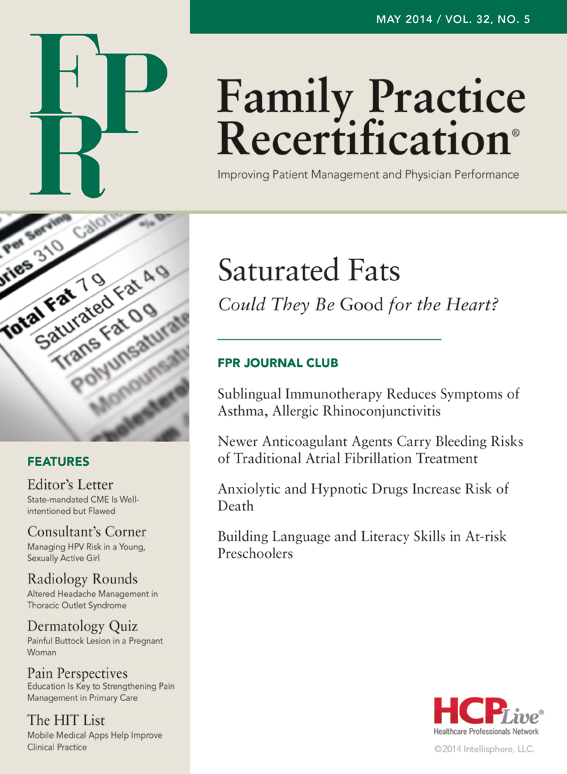Could Saturated Fat Be Good for the Heart?
Current dietary guidelines promoting high consumption of polyunsaturated fatty acids and low consumption of total saturated fats are not clearly supported by the medical literature.
Review
Chowdhury R, et al. Association of dietary, circulating, and supplement fatty acids with coronary risk: a systematic review and meta-analysis. Ann Intern Med. 2014;160(6):398-406. http://annals.org/article.aspx?articleid=1846638.
Study Methods
This systematic review analyzed data from prospective, observational studies and randomized controlled trials (RCTs) published before July 1, 2013, that included terms relating to saturated fats and coronary disease. The prospective observational studies were based on general or stable cardiovascular disease (CVD) populations and had at least 1 year of follow-up, while the RCTs reported coronary outcomes as an endpoint.
In total, there were 32 observational studies of dietary fatty acid intake in a combined 512,420 participants; 17 observational studies of circulating fatty acid composition in 25,721 participants; and 27 RCTs of fatty acid supplementation in 105,085 participants.
Study outcomes included the relative risk (RR) between fatty acids and coronary heart disease (CHD) and were often reported differently across trials, though the results were consistent when comparing the top third of baseline fatty acid intake to the bottom third in each study.
Results and Outcomes
Among the 32 observational studies reporting on dietary fatty acid intake and CHD risk, there was no significant difference in RR between groups, as the pooled RRs were 1.03 for total saturated fatty acids, 1.00 for total monounsaturated fatty acids, and 1.16 for total trans fatty acids. In the studies of fatty acid biomarkers and CHD risk, there was a moderate positive correlation between dietary intake and circulating composition of total omega-3 and omega-6 polyunsaturated fatty acids, but there was a weak positive correlation for total saturated and monounsaturated fatty acids.
In terms of circulating total fatty acid composition, the combined RRs were 1.06 for total saturated fatty acids, 1.06 for total monounsaturated fatty acids, 0.93 for alpha-linolenic acid, 0.84 for total long-chain omega-3 polyunsaturated fatty acids, 0.94 for total omega-6 polyunsaturated fatty acids, and 1.05 for total trans fatty acids. This lack of significant difference held true by individual saturated and monounsaturated fatty acids, as the RRs for palmitic, stearic, and oleic acids were 1.15, 1.23, and 1.09, respectively. In contrast, margaric acid was significantly associated with lower CHD risk.
Among specific polyunsaturated fatty acids, eicosapentaenoic, docosahexaenoic, and arachidonic acids were associated with lower risk, while dihomo-alpha linolenic, eicosadienoic, and docosatetrahexanoic acids tended toward a positive, albeit nonsignificant, association with CHD.
Of the RCTs on fatty acid supplementation and CHD risk, the RRs for coronary outcomes with alpha-linolenic acid, total long-chain omega-3 polyunsaturated fatty acids, and omega-6 polyunsaturated fatty acids were not significantly different.
Conclusion
Current cardiovascular (CV) dietary guidelines promoting high consumption of polyunsaturated fatty acids and low consumption of total saturated fats are not clearly supported by the medical literature.
Commentary
Dietary fats have been the subject of debate in recent literature due to their possible role in CHD. Currently, nutritional guidelines encourage low consumption of saturated fats, little to no consumption of trans fats, and high consumption of omega-3 polyunsaturated fats to improve CV health. However, the evidence supporting these recommendations is varied, and the optimal levels of each fatty acid are debated among the medical community.
While previous meta-analysis studies have focused on the differences between omega-3 and omega-6 fatty supplementation, this study centered on the association between fatty acids and CHD. In doing so, it attempted to determine whether the current CV dietary guidelines that recommend high polyunsaturated fat consumption and low total saturated fat intake are supported by the medical literature.
Overall, this review provided a detailed account of the available literature and effectively summarized it, demonstrating the current data does not support the current CV dietary guidelines. The authors also discussed some intriguing follow-up questions for areas of further study, including the real association between dietary intake and plasma levels of fatty acids, as well as the effects of other dietary substances on fatty acid levels.
One limitation of this review was some of the included studies were low in quality, yet still considered in the final analysis. Another concern was the authors’ use of studies that gave dietary fatty acids intake and biomarker levels equal weight in coronary events — an association that does not have strong evidence in the literature. Moreover, the authors acknowledged this relationship has been investigated before and no clear association has been established.
Some of the studies complicated the matter by demonstrating a dramatic effect of alcohol and carbohydrate intake on levels of even-numbered saturated fatty acids in the body. The authors also noted that when the available data was broken down further, there could have been a statistically significant association between trans fatty acids and coronary events.
Despite its limitations, this review adds to the growing voices in the medical world that the consumption of dietary fats has not been found to play the role we once thought. In this analysis, diets high in polyunsaturated fatty acids and low in total saturated fats did not provide a reduction in CHD risk, so for now, counsel your patients to follow a diet high in fruits, vegetables, and nuts and low in simple carbohydrates, such as the Mediterranean diet.
About the Authors
Nicholas Avgerinos, MD, is a recent graduate of the University of Massachusetts Medical School in Worcester, MA.
He was assisted in writing this article by Frank J. Domino, MD, Professor and Pre-Doctoral Education Director for the Department of Family Medicine and Community Health at the University of Massachusetts Medical School and Editor-in-Chief of the 5-Minute Clinical Consult series (Lippincott Williams & Wilkins).
